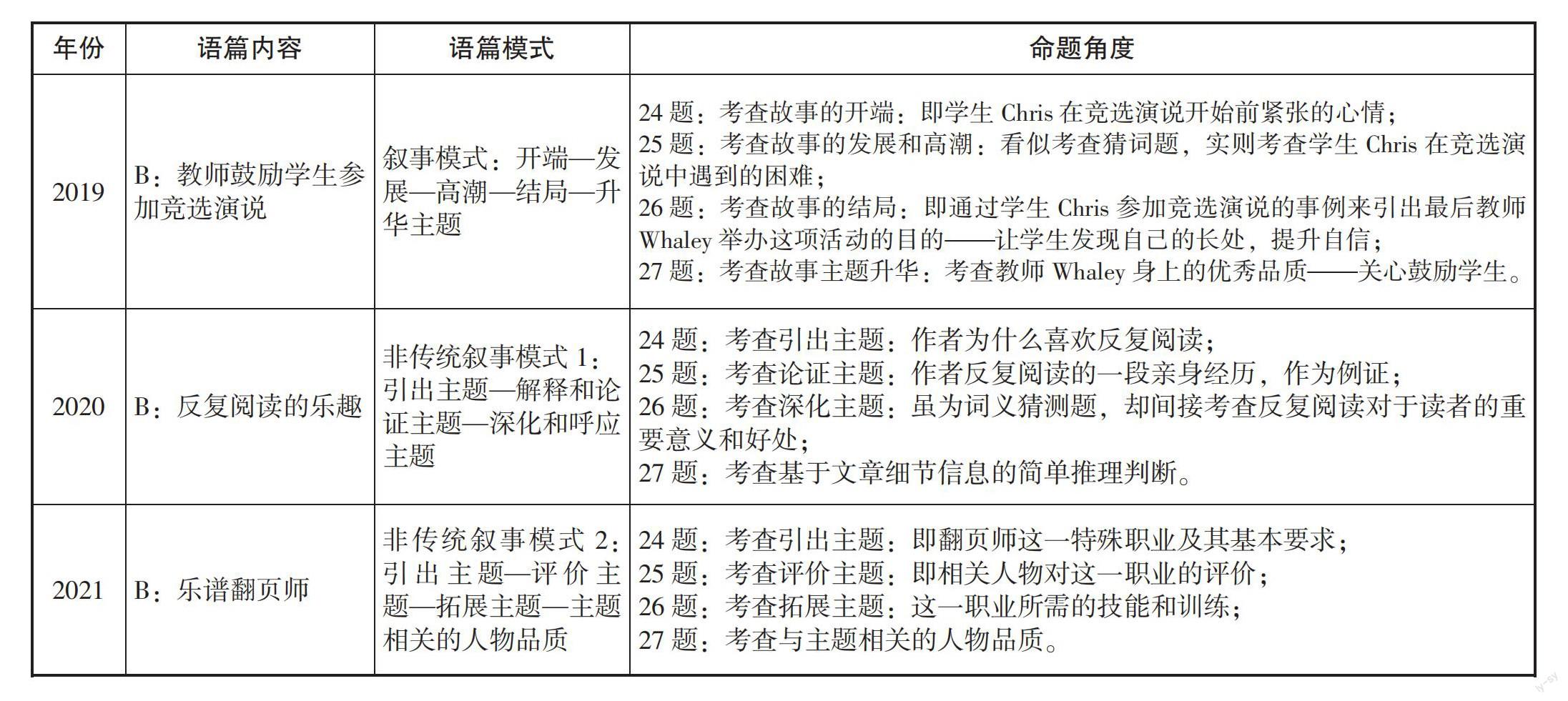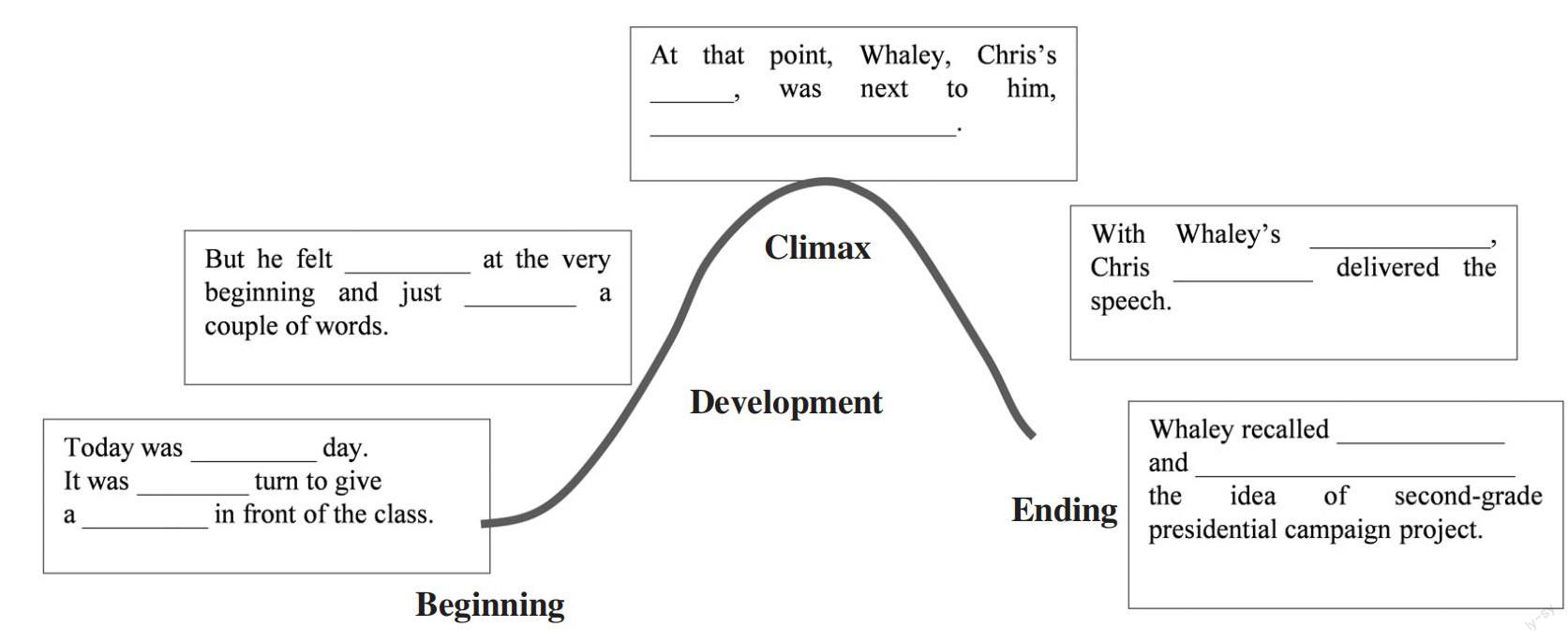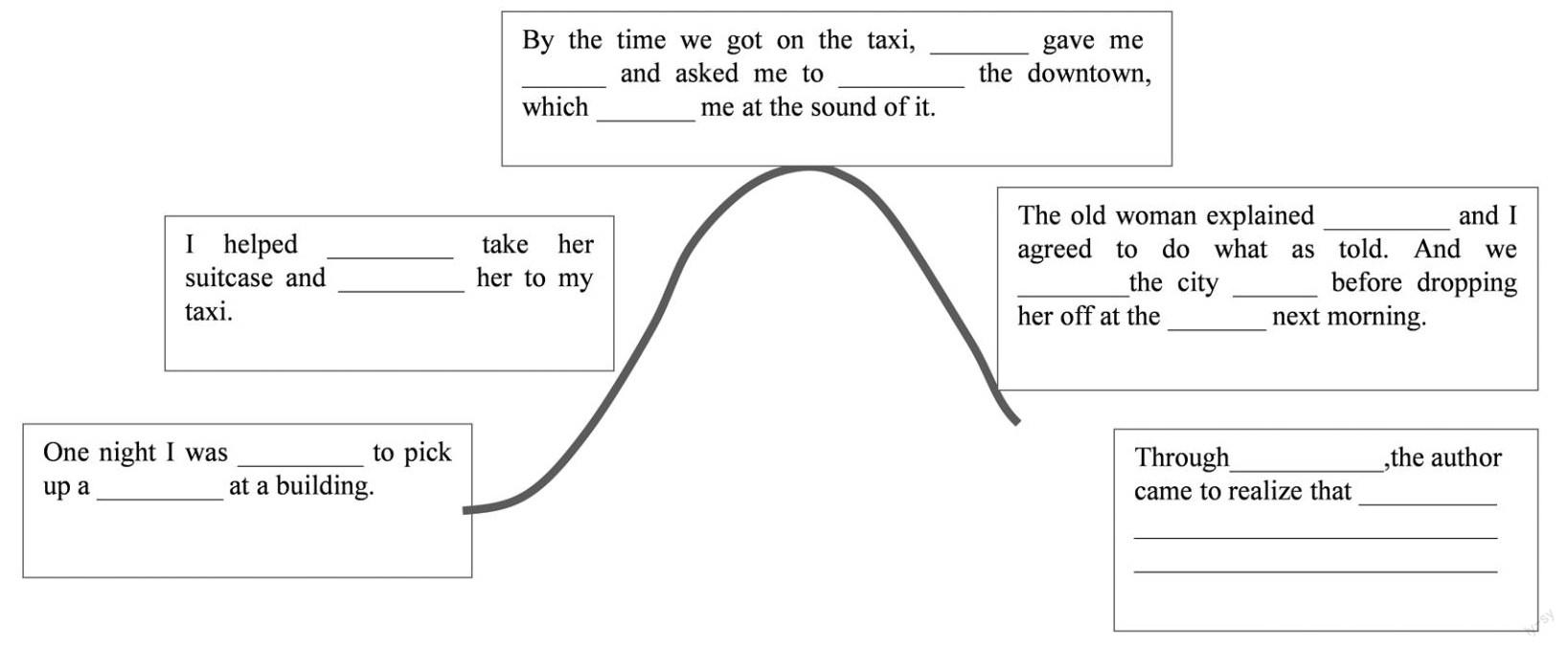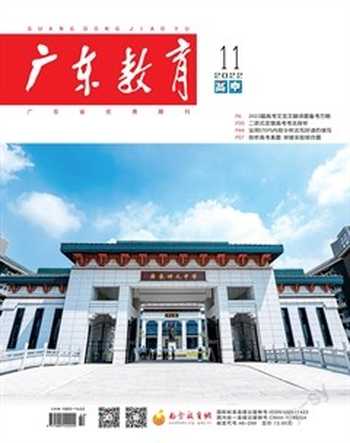基于语篇模式分析解读高考英语记叙文阅读
2022-05-30杨文彬
杨文彬



一、记叙文语篇模式
在历年高考英语阅读理解试题中,记叙文常见的语篇模式包括(1)叙事模式:“开端—发展—高潮—结局”或“开端—发展—高潮—结局—升华主题”;(2)非传统叙事模式:“引出主题—解释和论证主题—深化并呼应主题”或“引出主题—评价主题—拓展主题—主题相关的人物品质”等。为指导该文体的阅读教学与备考,本文采用语篇分析视角,对近5年的广东高考英语试题的阅读理解记叙文语篇和试题进行解读,探究在教学和备考中如何二次开发真题,帮助考生习得并内化记叙文语篇模式,提升其阅读能力。
二、基于语篇分析解读高考英语记叙文阅读
下面以近5年(2018-2020年全国I卷及2021-2022年新高考全国I卷)的广东省高考英语试题中阅读理解的记叙文共3篇文本作为研究素材,从语篇内容、语篇模式、命题角度等方面进行解读,分析如下:
从近5年广东高考英语阅读理解试题来看,2018年和2022年均没有在阅读理解部分考查记叙文,而2019至2021年连续3年均考查1篇记叙文,由此可见,在数量上远不及说明文语篇。究其原因,历年高考英语试题中完形填空和近两年的读后续写均以记叙文为主,基于在整张试卷中均衡考查各语篇类型及语篇结构类型的考虑,在阅读理解部分年均考查1篇记叙文或有些年份没有考查也就顺理成章了。接下来,本文将详细解读近5年广东高考英语阅读理解记叙文语篇的考查角度。
2.1叙事模式:开端—发展—高潮—结局—升华主题
该类语篇模式的真题文本包括2019年B篇。该篇第24题What makes Chris nervous?题干问学生Chris紧张的原因,即参加竞选演讲,指向故事的开端。
而该篇第25题What does the underlined word“stumbles” in paragraph 2 refer to?为词义猜测题,实际上是考查Chris在演讲过程中遇到的困难,即故事的发展和高潮。
第26题We can infer that the purpose of Whaleys project is to__________. 题干问Whaleys project,即鼓励学生参加竞选演讲的目的,指向故事的结局。
第27题Which of the following best describes Whaley as a teacher?题干询问最佳形容词描述教师Whaley,事实上是对主题相关的人物品質的评价,即升华主题。
2.2非传统叙事模式1:引出主题—解释和论证主题—深化并呼应主题
该类语篇模式的真题文本包括2020年B篇。命题角度中关于引出主题的考查体现在2020年B篇24题Why does the author like rereading?题干问作者为什么喜欢反复阅读,即开门见山、引出主题:反复阅读可以深化读者对自我的认识。
而该篇文章第25题What do we know about the book A Moveable Feast? 题干问作者反复阅读的一段关于阅读海明威作品的亲身经历,旨在论证前文主题,即解释和论证主题。
第26题What does the underlined word“currency”in paragraph 4 refer to?题干虽为词义猜测题,却间接考查反复阅读对于读者的重要意义和好处,即在前文举例论证的基础上,进一步深化和呼应了开头段引出的主题。
2.3非传统叙事模式2:引出主题—评价主题—拓展主题—主题相关的人物品质
该类语篇模式的真题文本包括2022年B篇。命题角度中关于引出主题的考查体现在第24题What should Titterton be able to do to be a page turner?题干问主人公如何才能成为一名翻页师,引出这一特殊职业及其基本要求,即引出主题。
而该篇文章第25题Which of the following best describes Tittertons job on stage?题干要求运用最佳形容词描述这一职业,是对这一特殊职业的评价的考查,即评价主题。
第26题What does Titterton need to practise? 题干问成为一名合格的翻页师需要什么样的练习,即考查拓展主题:这一职业所需的技能和训练。
第27题Why is MsRaspopovas husband“the worse page turner”?题干通过引用翻页师的妻子对丈夫工作的评价,考查了主题相关的人物品质。
三、基于试题解读反拨记叙文阅读教学的实践探索
在上述解读的基础上,本节将继续探索记叙文语篇的“真题文本—课堂教学—教材拓展文本—泛读练习”的闭环实践模式和基于语篇层面的真题二次开发,为下一步指导学生精读,习得文体类型和语篇结构模式等奠定素材基础,具体案例及分析如下:
案例1:2019年高考全国I卷阅读理解B篇记叙文真题二次开发指导语篇课堂精读设计(建议用PPT呈现)
Task 1: Go through the passage quickly and figure out the text type.(PPT第1页)
A:Narration
B:Argumentation
C:Exposition
D:Practical writing
Task 2: Scan the passage again and figure out the text structure.(为了更好地帮助学生习得语篇结构类型,此处的选项可以用中文表示,以降低学生对英语术语的认知负担)(PPT第1页)
A: 传统叙事模式:开端—发展—高潮—结局—升华主题
B: 非传统叙事模式:引出主题—解释和论证主题—深化并呼应主题
C: 非传统叙事模式:引出主题—评价主题—拓展主题—主题相关的人物品质
Task 3:Based on Task 2, reread the passage and complete the story mountain below.(PPT第2页)
Task 4: Read and discuss the question with your partners.
Q: How do you like the teacher Whaley in the story?
Q: What kind of person is Whaley?
Q: What is the theme conveyed by this passage?
Task 5:
Version1:Based on Task 3, complete the reading comprehension questions related to each part of the plots in story mountain and the theme of the story. (针对基础比较一般或薄弱的学生,教师可以让学生在准确把握全文语篇结构和逻辑链后,直接让学生顺势完成高考原题,检测对文章语篇结构和主要细节的理解和掌握程度)(PPT第3页)
Q1: What made Chris nervous?
A. Telling a story. B. Making a speech.
C. Taking a test. D. Answering a question.
Q2: What does the underlined word“stumbles”in paragraph 2 refer to?
A. Improper pauses. B. Bad manners.
C. Spelling mistakes. D. Silly jokes.
Q3: We can infer that the purpose of Whaleys project is to _________.
A. help students see their own strengths
B. assess studentspublic speaking skills
C. prepare students for their future jobs
D. inspire studentslove for politics
Q4:Which of the following best describes Whaley as a teacher?
A. Humorous. B. Ambitious.
C. Caring. D. Demanding.
Version2:Based on Task 3, work in a group of four and work together to come up with at least two reading comprehension questions for each part of the plots in story mountain and the theme of the story.(針对基础比较好的的学生,教师可以让学生在准确把握全文语篇结构后,通过自主命题的形式,在语篇模式的指导下,加深对文章主要细节的理解,站在更高角度解读文章)(PPT第4页)
此外,教师还可以在此基础上进一步开发教材文本(如人教版高中英语新教材的Workbook的单元拓展语篇素材)作为泛读材料,助力学生内化在精读过程中习得的语篇类型和语篇结构模式等知识,具体案例如下:
案例2:人教版新教材必修三第2单元Morals and Virtues的Workbook P70-71拓展阅读语篇:The Taxi Ride Ill Never Forget泛读(可布置成课后巩固学案或作业)
Extensive reading worksheet/Assignment
Task 1: Go through the passage on P70-71 of the workbook in Book 3 and figure out the text type.
A:Narration
B:Argumentation
C:Exposition
D:Practical writing
Task 2: Scan the passage again and figure out the text structure.
A:传统叙事模式:开端—发展—高潮—结局—升华主题
B:非传统叙事模式:引出主题—解释和论证主题—深化并呼应主题
C:非传统叙事模式:引出主题—评价主题—拓展主题—主题相关的人物品质
Task 3:Based on Task 2, reread the passage and complete the story mountain below.
Task 4:
Version1: Based on Task 3, complete the reading comprehension questions related to each part of the plots in story mountain and the theme of the story.
Q1: When and where did the story happen and who are the main characters?(Beginning)
Q2: What did the author do when he arrived at the building?(Development)
Q3: How did the author feel when the old woman told him what to do? Why?(Climax)
Q4: What was the real intention of the woman and how did the story come to an end?(Ending)
Q5: What kind of person is the author?
Q6: What theme does the story intend to convey?
Version2:Based on Task 3, come up with at least two reading comprehension questions related to each part of the plots in story mountain and the theme of the story.
綜上所述,教师在完成对高考英语记叙文语篇模式的相关命题解读后,可对真题文本在语篇层面进行二次开发,在对应的关键部分设置导读问题,对标高考阅读理解的命题角度,并在课堂上开展精读教学,助力学生学习掌握高考常考的记叙文语篇模式等相关知识。此外,还可挖掘与高考真题语篇模式相似的教材拓展语篇,让学生通过泛读(课后巩固练习或作业),应用和实践课上所学,达到精读与泛读的协同效应,实现“真题文本—课堂教学—教材拓展文本—泛读练习”的闭环,提升“教学评一体化”。
责任编辑 吴昊雷
